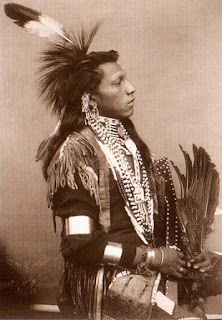Mandan Indian Village is Described
The Mandan village contained at the time of Catlin's visit (1832), as elsewhere stated, about fifty houses and about fifteen hundred people. "These cabins are so spacious," Catlin remarks, "that they hold from twenty to forty persons—a family and all their connections…. From the great numbers of the inmates in these lodges they are necessarily very spacious, and the number of beds considerable. It is no uncommon thing to see these lodges fifty feet in diameter inside (which is an immense room), with a row of these curtained beds extending quite around their sides, being some ten or twelve of them, placed four or five feet apart, and the space between them occupied by a large post, fixed quite firmly in the ground, and six or seven feet high, with large wooden pegs or bolts in it, on which are hung or grouped, with a wild and startling taste, the arms and armor of the respective proprietors." [Footnote: North American Indians, Philadelphia ed., 1857, i, 139.]
The household, according to the custom of the Indians, was a large one. The number of inhabitants divided among the number of houses would give an average of thirty persons to each house. It is evident from several statements of Catlin before given that the household practiced communism in living, and that it was formed of related families, on the principle of gentile kin, as among the Iroquois. Elsewhere he intimates that the Mandans kept a public store or granary as a refuge for the whole community in a time of scarcity.
In like manner Carver, speaking generally of the usages and customs of the Dakota tribes and of the tribes of Wisconsin, remarks that "they will readily share with any of their own tribe the last part of their provisions, and even with those of a different nation, if they chance to come in when they are eating. Though they do not keep one common store, yet that community of goods which is so prevalent among them, and their generous disposition, render it nearly of the same effect." [Footnote: Travels, etc, p. 171.]
What this author seems to state is that community of goods existed in the household, and that it was lengthened out to the tribe by the law of hospitality. Elsewhere, speaking of the large village of the Sauks, he says: "This is the largest Indian town I ever saw. It contains about ninety houses, each large enough for several families." [Footnote: Travels, etc., Phila. ed. 1796, p. 29.]


